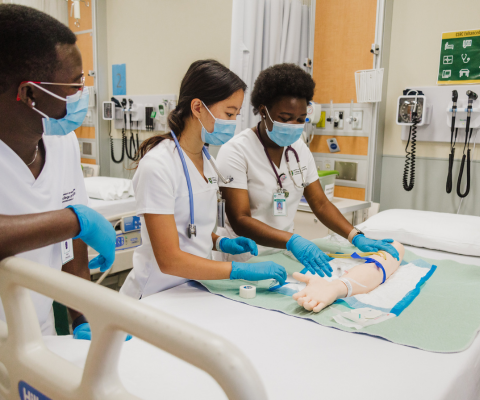Advancing Canada’s research & innovation leadership

This op-ed was published in Research Money on February 24, 2014.
By Paul Davidson, president, Association of Universities and Colleges of Canada
Budget 2014 sent up a flare to the world: we are on our way with a bold new research and innovation initiative that will advance Canada internationally. To the community within our borders, it signals a new narrative, one that focusses on opportunity.
The newly-announced Canada First Research Excellence Fund (CFREF), coupled with the largest support of the country’s research granting councils in nearly a decade, represents a catalytic investment.
First, the budget recognizes the nature of research. Government budgets traditionally have projected no more than two years forward. This commitment of $1.5-billion over 10 years to the research excellence fund — and enhanced ongoing funding for the granting councils and indirect costs of research provides certainty, sustainability and predictability. Planning well into the future is now a possibility, allowing for a continuum of discovery, building on previous or soon-to-come knowledge.
The CFREF also recognizes that research excellence takes place at universities of all sizes and in all regions of the country. University presidents called for an open, competitive and peer-reviewed program. This initiative will reflect that. So any university can compete, no matter its size or location. What will matter is the level of excellence, knowledge and talent being brought to the research and innovation table. The benefits will be shared by faculty, students and communities across Canada.
And on a third level, the research excellence fund speaks to the importance of international collaboration. It acknowledges that a world-class research system is a critical element of a vibrant, innovative and competitive economy. We can compete. But in today’s global village, collaboration is what moves us forward. As we bring up our game, we can look forward to a continued building and leveraging of global partnerships that are already under way.
The newest generation of Canadian university faculty members has laid the groundwork. They have studied abroad and are connected with colleagues around the world. They think in global terms. They are twice as likely as researchers elsewhere to produce jointly-authored international work, which makes them among the most collaborative in the world. In fact, top-cited international researchers recognize their Canadian peers as leaders in terms of the originality, impact and rigour in their field of research.
The new fund will allow Canada to continue expanding that. We know the opportunities are there. Last year, the Association of Universities and Colleges of Canada (AUCC) and the Association of University Heads, Israel agreed to collaborate to promote the internationalization of higher education and to work towards increased research links with Israeli universities.
International outreach
An unprecedented AUCC-led mission of university presidents to Brazil—a nation spurring prosperity by investing heavily in research and innovation—resulted in more than 75 new university partnerships and scholarship programs. A similar AUCC-led mission of presidents to India in November 2010 raised Canada’s higher education profile in that country, and forged connections that continue to enhance academic and research collaboration.
Those connections are being further deepened during Governor General David Johnson’s current state visit to India. I will be accompanying the Governor General as we visit universities, talk to innovators and entrepreneurs, and discuss how best to address global challenges during an innovation roundtable in New Delhi.
Canada was early out of the gate in establishing international linkages, and our universities are building on these. Canada protected investments in research during the economic downturn. Our universities have been able to stem the historical brain drain and attract outstanding faculty, undergraduate and graduate students and post-doctoral fellows. New investments will allow us to pick up speed and hold on to our advantage.
As this program rolls out, universities will have the resources to build their performance in key areas: global excellence, talent and knowledge translation. Funding from the CFREF will build Canada’s reputation as a destination and a home for innovators, research talent and cutting-edge discovery. Universities receiving support will have the flexibility and nimbleness they’ll need to respond quickly to dramatic advancements or valuable partnerships in select areas. The potential for clusters of research excellence in concentrated fields is tremendous.
This new investment goes beyond spurring academic successes. The research excellence fund will heighten Canada’s capacity to attract and retain the best talent from Canada and around the world to remedy emerging shortages of highly skilled labour. We’ll be better able to stimulate the rate of ground-breaking discoveries. We’ll see increased opportunities to establish Canadian universities as preferred partners for the best international research institutions. Universities will also be able to enhance their efforts to reach out to businesses that are ready to adapt and exploit discoveries. And that will help Canadian businesses become more globally competitive.
Our universities are making those connections. They already conduct nearly $1-billion of research funded by the private sector in Canada each year, providing the “intellectual raw material” that drives innovation and builds prosperity.
An even larger share of research, more than $1-billion, is conducted by universities with funding from community and non-profit groups, particularly in the area of health. With secure, reliable and predictable support behind them, just imagine what they can achieve.
We all benefit from the results, and so for Canada, this is a pivotal moment.
We couldn’t be more ready for this bold investment. Half of the faculty members working at Canadian universities have been hired in the last decade. Together with more senior colleagues, they are making large contributions and are ready to do more. We’ve also seen dramatic growth in the number of graduate students at our universities of almost 90% since 2000.
That bench strength, combined with this new certainty, gives Canada’s universities the flexibility to pursue their priorities and missions and perform at their best. Driven by quality research and innovation, Canada will do the same.
About Universities Canada
Universities Canada is the voice of Canada’s universities at home and abroad, advancing higher education, research and innovation for the benefit of all Canadians.
Media contact:
Lisa Wallace
Assistant Director, Communications
Universities Canada
[email protected]
Related news
-

BCDI 2030 launches second round of funding for scholarship projects for study in Canada
-

Universities are advancing technology through international partnerships
-

Universities Canada's response to Minister Miller's announcement on international student caps
-

How international research partnerships are helping us tackle world health issues
